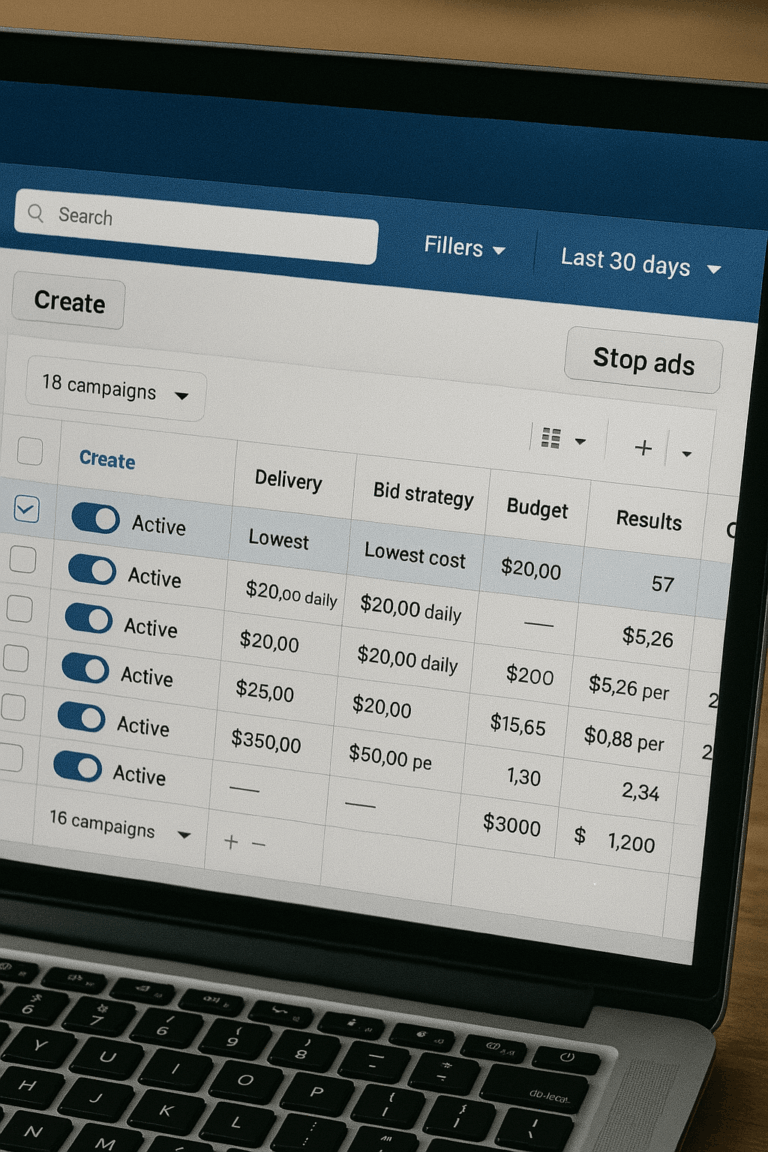How to Analyze Marketing Data After an Incrementality Test

Running an incrementality test is one of the most effective ways to determine whether your marketing efforts are truly generating incremental revenue. But what most teams miss is that the real value doesn’t come from the test itself; it comes from what you do immediately afterward.
You’d be surprised how often brands run sophisticated tests, receive high-value insights, and then fail to act. They don’t adjust spend, don’t shift strategy, and don’t translate learnings into measurable outcomes.
If you’re trying to understand how to analyze marketing data in a way that actually drives decisions, this guide breaks down what to look for, how to interpret your results, and how to turn measurement into long-term marketing strategy.
Why Many Brands Misinterpret Marketing Data
After analyzing thousands of incrementality tests across dozens of industries, one pattern is clear:
Most brands don’t have a decision-making framework for interpreting results from their marketing efforts.
They look at dashboards. They check a few KPIs. They skim the marketing reporting done by their measurement partner.
However, they lack a repeatable, strategic process for turning marketing data into actionable insights.
A good marketing analytics strategy requires you to:
- Know what you’re measuring
- Understand why the results look the way they do
- Decide how your marketing strategy changes because of it
That’s where incrementality experiments often go wrong, and where a structured approach becomes essential.
Step 1: Start With the Right Question
Before you can analyze any marketing data, especially incrementality results, your team must clearly define the decision the test should help you make.
Ask These Three Questions Every Time:
1. What decision am I trying to make?
Examples:
- Are we looking to scale certain marketing channels?
- Should we diversify into new placements?
- Should we focus on budget allocation to higher-incrementality campaigns?
2. What information do I need to make that decision?
Examples:
- Incremental ROAS vs. required profitability
- Impact by audience, geo, or placement
- Whether the tactic is adding new customers vs. recycling existing ones
3. What actions will I take depending on the results?
Examples:
- Increase spend by 20–30%
- Maintain investment and test new creative
- Reduce investment and reallocate to stronger channels
Without this clarity up front, your marketing team will end up with a report, not actionable insights or informed decisions. And you’ll fall into the trap of doing analysis for analysis’s sake.
Step 2: Look Beyond a Single Metric
When learning how to analyze marketing data, marketing professionals often focus on one key metric: iROAS.
But incrementality data must be interpreted in context. Otherwise, you risk making decisions based on incomplete signals.
Here’s what advanced marketers evaluate to keep their competitive edge:
a. Required vs. Observed iROAS
If your required iROAS is 2.0 to break even and your test shows 3.0, that’s a green light.
But iROAS alone doesn’t tell you:
- Whether results are stable
- Whether scaling will dilute incrementality
- Whether the sales channel impacts long-term customer value
iROAS is essential, but it’s only step one.
b. Incremental Revenue vs. Spend Levels
If a channel is delivering strong iROAS at low spend levels, you should test whether performance holds when budget increases.
That requires post-test monitoring by stakeholders, not a one-and-done result.
c. Impact on New Customer Acquisition
One of the most overlooked steps in marketing data analysis is evaluating whether the channel:
- Is where their target audience discovers brands
- Changes repeat behavior
- Influences the overall customer mix
Incrementality without incremental customer value is a false positive.
d. Channel Synergies
Some channels create lift in others, but this lift won’t appear in platform attribution:
- YouTube → increases branded search
- TikTok → improves Meta conversion rates
- OOH → improves return customer reactivation
You’re not only analyzing what happened, you’re identifying second-order effects.
Step 3: Translate the Data Into a Clear Action Plan
Once you understand what data collection entails, the next step is to translate the insights into actionable steps. This is where most marketers fail to support their business goals.
Let’s walk through the full analysis process using a realistic scenario.
Scenario: A Channel Shows a 3x iROAS
The data:
- Channel spend: $50,000/mo
- iROAS: 3.0
- Profit requirement: 2.0
- Contribution margin positive
The correct analysis approach:
This channel is outperforming your break-even threshold, which means it is both profitable and incremental. You should scale it strategically.
Here’s the structured action plan:
1. Increase Budget From $50K → $60K
When analyzing marketing performance data, your first step is to test elasticity:
Will incremental results remain stable at higher spend?
A controlled increase of 10–20% is ideal.
This ensures you don’t introduce unnecessary volatility.
2. Keep All Other Variables Constant
This includes:
- Creative
- Audience
- Frequency
- Placements
- Funnel configuration
- Landing page
If you change too much too quickly, you can’t reliably interpret the quality of the results.
3. Monitor Impact Against Historical Baselines
This is where true data analysis skills matter.
Track:
- Revenue curves vs. pre-test periods
- New customer mix
- MER and contribution margin
- Cohort behavior
- Blended CAC
For example, if revenue rises proportionately with spend increase, scaling is validated.
4. Re-Test if Results Are Inconsistent
If the lift is unstable, you may need:
- A longer measurement window
- A follow-up geo experiment
- A new incrementality test in a fresh audience segment
- Creative improvements before the next test
Incrementality isn’t a one-time project; it’s a continuous loop.
What If the Results Are Negative?
If the test shows low or negative iROAS, here’s how to interpret the data:
a. Reduce spend and shift to higher-performing channels: Budget reallocation is the simplest and highest-impact optimization.
b. Improve creative before abandoning the channel: Incrementality often rises once the creative matches the platform’s native content style.
c. Fix targeting issues: Sometimes a channel isn’t ineffective; it’s misaligned with the audience.
d. Review seasonality or competitive pressure: Your test timing matters. Not all periods are equal.
e. Validate your setup
Bad tracking = bad conclusions.
Bad geo selection = bad conclusions.
Bad baselines = bad conclusions.
You must confirm that the test itself was structurally sound.
Step 4: Apply Full-Funnel Data Analysis Techniques
Understanding how to analyze marketing data requires more than reading headline KPIs.
You must think holistically by using multiple analytics lenses to see the full picture.
Here’s what advanced teams evaluate:
1. Cohort Performance
Did the customers acquired during the test period behave differently?
- Higher OR lower repeat rates?
- Higher OR lower AOV?
- Higher OR lower churn?
Incrementality isn’t just about first-order revenue.
2. Cross-Channel Influences
How did other channels behave during the test?
- Did branded search spike?
- Did organic traffic lift?
- Did Meta deliver more efficient conversions?
Incremental value often shows up indirectly.
3. Contribution Margin and MER
Some channels have “hidden incrementality” that surfaces only when you zoom out to a P&L level.
MER improvement = real business impact.
4. Customer Behavior and Time-Lag Effects
Marketing analytics requires understanding delays:
- High-consideration buyers take longer to convert
- TOF channels often show delayed ROI
- Some channels increase future demand, not immediate revenue
Your analysis must reflect these dynamics.
Step 5: Build an Actionable Marketing Strategy From the Data
Once you’ve interpreted the test, analyzed the cohorts, considered benchmarks and evaluated the cross-channel effects, you now have enough business insight and customer data to build a strategic roadmap.
Examples of strategic recommendations:
- Scale High-Incrementality Channels: Increase spend where iROAS > required threshold.
- Optimize Messaging and Creative: Testing can reveal which hooks, formats, and angles truly move incrementality.
- Reallocate Low-Incrementality Budgets: Shift spend to channels generating measurable lift.
- Prioritize Long-Term Growth Metrics: Blend iROAS with customer lifetime value, cohort retention, and contribution margin.
- Create a Continuous Learning Agenda: Data analysis only matters if the insights it provides compound over time.
The Real Purpose of Marketing Data Analysis
If you want to understand how to analyze marketing data effectively, start here:
The purpose of measurement is to make decisions.
The purpose of data is to change strategy.
The purpose of analysis is to unlock growth.
Every incrementality test should:
- Produce a decision
- Change an allocation
- Improve a strategy
- Strengthen your long-term growth model
If it doesn’t, it wasn’t analysis, it was a report.
Need Help Turning Data Into Action?
Most brands aren’t struggling with measurement.
They’re struggling with interpretation.
At fusepoint, we help teams:
- Analyze incrementality data
- Build decision-ready frameworks based on their business needs
- Create scalable, profitable media strategies
- Turn tests into revenue-driving actions
If you want deeper clarity into what your data is telling you. If you’re not sure how to interpret your latest test. Or if you want help building structured decision-making system
Book a consultation with a marketing science company today — and start making data work for you, not against you.
Our Editorial Standards
Reviewed for Accuracy
Every piece is fact-checked for precision.
Up-to-Date Research
We reflect the latest trends and insights.
Credible References
Backed by trusted industry sources.
Actionable & Insight-Driven
Strategic takeaways for real results.

















